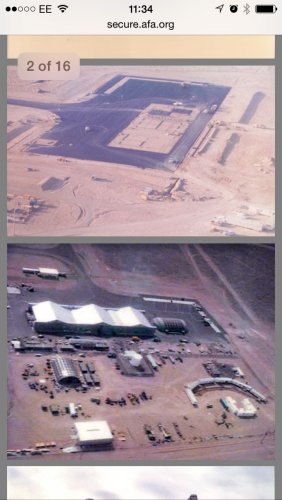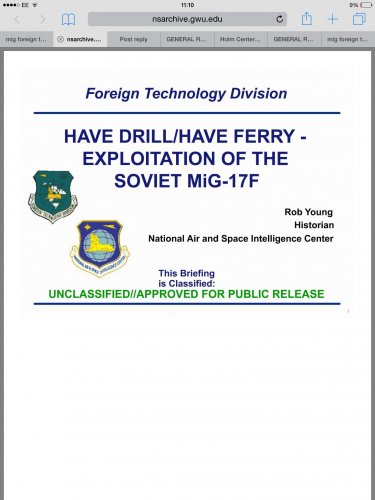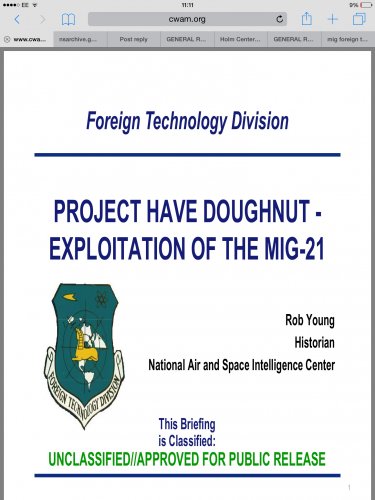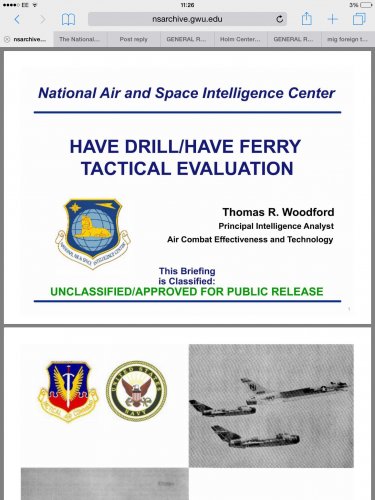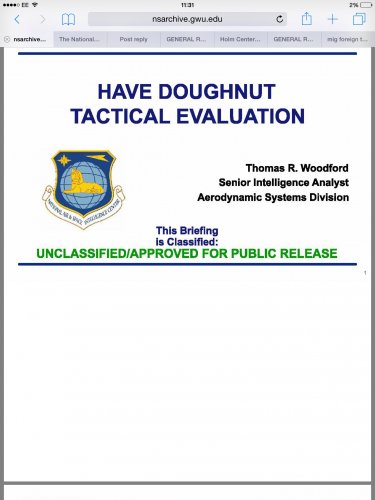The practice of using non-standard designations began with Project HAVE DOUGHNUT in 1968. Project pilots Fred Cuthill and Joe Jordan were trying to figure out how to log the flight time in the AF Form 5. For security reasons, they obviously couldn't list the airplane as a MiG-21. The solution was to use a designation that had not been previously used, and would never be assigned to a production aircraft. The "Century Series" designations had been phased out in 1962, and only one designation was needed for the project. They picked YF-110B since YF-110A had been briefly used to designate the Air Force version of the F4H-1 before it was formally designated F-4C.
Now, a lot of people would like to draw a straight line between the YF-110B and the YF-117A with all the known and missing designations in a neat row, but it didn't work that way. The numbers were not assigned in any linear or logical order. In 1969, two MiG-17F (Lim-5M) aircraft were acquired for evaluation purposes. Although the two airplanes were physically identical and were sometimes even flown together on dual sorties, they each received separate designations and project names. The HAVE DRILL project aircraft was designated YF-113A. Because the AF Form 5, at that time, did not accommodate tail numbers, the HAVE FERRY project aircraft was designated YF-114C.
In 1970, Wendell Shawler flew a Chinese-built MiG-17F (J-5) at Phu Cat Air Base, Vietnam under Project HAVE PRIVILEGE. He used the designation YF-113C. This designation was recycled in the early 1990s for a completely different aircraft. I suspect the later generation of Red Hats was unaware that the YF-113C designation had been used previously.
Project HAVE GLIB, established in 1970, became the umbrella program for early foreign materiel evaluation (FME) projects. The YF-114C was joined by a MiG-17PF (designated YF-114D), and several MiG-21s. Since, by this time the AF Form 5 had been modified to accommodate tail numbers, the MiG-21s were all designated YF-110B.
In 1973, foreign aircraft evaluations were placed under the HAVE IDEA umbrella program. HAVE GLIB apparently continued, in some form, at least into the 1980s. Circumstantial evidence suggests a connection to foreign radar studies. HAVE IDEA was replaced by HAVE PHOENIX in 1986. Individual aircraft are often associated with additional project names (HAVE PAD, HAVE BOAT, etc.).
The Red Hats refer to the FME aircraft as "classified prototypes." Although they are not true prototypes, the airplanes are used for experimental and developmental testing (the latter being more along the lines of operational test and evaluation). Non-standard designations were also applied advanced technology demonstrators and full-scale development prototypes of domestic manufacture (YF-117A, YF-118G, etc.). Recently, a few two-digit designations have surfaced, as well.
Confusion about a "classified prototype" called the YF-113G results from the fact that the only known pilots to have flown it were Red Hats, but the "Classified Flight Test Squadron" that operated it reportedly took the airplane "from design to first flight" (suggesting a new type rather than a foreign production model).
So, we have identical aircraft with different designations and different aircraft with identical designations. We have designations assigned out of numerical sequence and some apparently skipped altogether (YF-115 ?). For what it's worth, below is a list of known designations.
YF-110B MiG-21-F13 HAVE DOUGHNUT (tail number 80695, later 007) ex-Iraqi AF, 1968; HAVE GLIB, HAVE IDEA
YF-110B MiG-21-F13 HAVE GLIB, HAVE IDEA (tail number 004), ex-Indonesian AF, built from parts, 1972-? ???
YF-110B MiG-21-F13 HAVE GLIB, HAVE IDEA (tail number 010), ex-Indonesian AF, built from parts, 1972-? ???
YF-110C MiG-21-F13/J-7B CONSTANT PEG (various tail numbers), ex-Indonesian AF, built from parts
YF-110D MiG-21MF HAVE COAT and CONSTANT PEG (?), 1980-1988
YF-110E Classified aircraft, HAVE PHOENIX, stores carriage and separation, circa 1991
YF-110L Classified aircraft, HAVE PHOENIX, stores carriage and separation, circa 1986-1992
YF-110M Classified aircraft, HAVE PHOENIX, stores carriage, separation, envelope expansion, circa 1986-1993
YF-112C Possibly Su-17 HAVE UP, 1979 [unconfirmed]
YF-113A MiG-17F/Lim-5M HAVE DRILL (tail number 055), ex-Syrian AF
YF-113B MiG-23BN HAVE PAD, ex-Egyptian AF, 1978
YF-113C MiG-17F/J-5 HAVE PRIVILEGE (tail number 1024), Chinese-built, Cambodian Khmer AF, 1970
YF-113C Classified aircraft tested circa 1992 as part of HAVE PHOENIX
YF-113E MiG-23MS HAVE PAD, ex-Egyptian AF, 1978-1987
YF-113G Classified prototype aircraft, flying qualities, avionics, circa 1993-1995, possibly a FME program
YF-113H Classified aircraft tested circa 1987-1988 as part of HAVE PHOENIX
YF-114C MiG-17F/Lim-5M HAVE FERRY (tail number 002), ex-Syrian AF, HAVE GLIB, and CONSTANT PEG
YF-114D MiG-17PF (tail number 008), HAVE GLIB, HAVE IDEA, circa 1972
YF-116A Classified aircraft (HAVE LOAN ?), HAVE PHOENIX, performance, envelope expansion, avionics, propulsion, circa 1991-1992
YF-117A Lockheed SENIOR TREND FSD aircraft (tail numbers 780 through 784), 1981-2008
F-117A SENIOR TREND production aircraft (tail numbers 785 through 843), 1982-2008
YF-117D Northrop TACIT BLUE stealth technology demonstrator, 1982-1985
YF-118G Boeing Bird of Prey stealth technology demonstrator. 1996-1999
YF-24A Classified prototype aircraft, circa 1997
YF-43B Classified prototype aircraft, circa ??? ?




